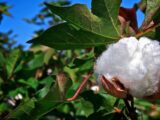
There are many reasons that a farmer chooses to grow a specific selection of crops, including cotton. In Australia in most seasons, the majority of the cotton crop is irrigated, and irrigation farmers have a choice about which crops to plant with the water they are licensed to access (under strict conditions). Considerations include:
- Assessing water availability for the coming season and then selecting the crop that will provide the highest financial return per unit of water. For many irrigators in NSW and Queensland, that crop is cotton.
- Cotton and other annual crops are ideally suited to the Murray-Darling Basin as their plantings can be flexible to meet the changing water availability from season to season. Perennials like grapevines and citrus trees require water every year, whether it's available or not.
- Cotton growers do not plant cotton on all their land every year. The planting area is dependent upon available water and crop rotations to ensure optimum soil health. Up to 30% of a famers land will be rested on an annual basis (i.e. there is no crop grown at all).
- Cotton growers grow other crops like sorghum, soybeans, wheat, and also have cattle.
- Cotton is a desert plant that is water efficient, suits Australia’s climate, is grown as an annual crop, and is only grown when sufficient water is available.
- Other summer crops, like corn and soybeans, use similar amounts of water per hectare.






